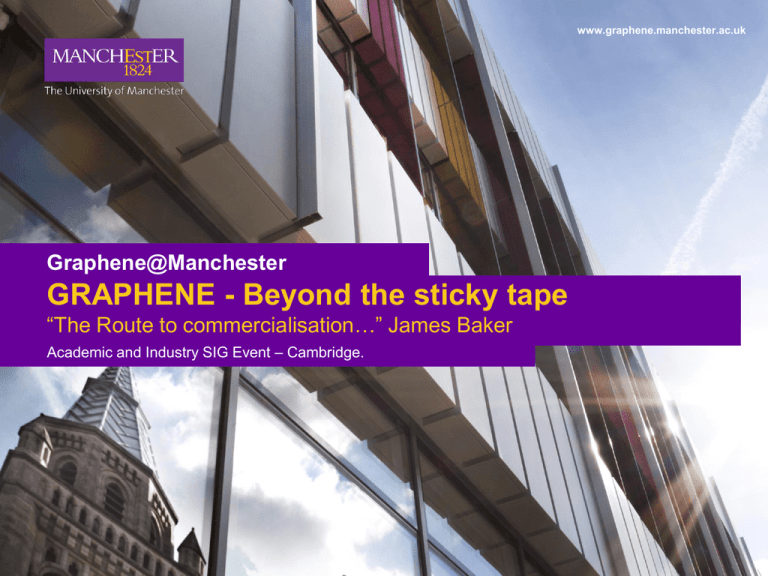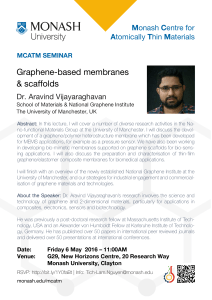BEST Presentation PPT file
advertisement

www.graphene.manchester.ac.uk Graphene@Manchester GRAPHENE - Beyond the sticky tape “The Route to commercialisation…” James Baker Academic and Industry SIG Event – Cambridge. 1 Graphene superlatives thinnest imaginable material strongest material ever measured (theoretical limit) stiffest known material (stiffer than diamond) most stretchable crystal (up to 20% elastically) record thermal conductivity (outperforming diamond) highest current density at room T (million times of those in copper) highest intrinsic mobility (100 times more than in Si) conducts electricity in the limit of no electrons lightest charge carriers (zero rest mass) longest mean free path at room T (micron range) most impermeable (even He atoms cannot squeeze through) ……? 2 Producing graphene 3 Mechanical Electrical conductivity • • • CVD graphene Optical Permeability Rollable epaper Foldable OLED display Touch screen Thermal Heat sink for semiconductors Barrier coating for cupper connects in electronics Electromagnetic shield layer Biocompatibility • Wound dressing management Biomaterials for regenerative medicine ‘smart’ biomaterials Drug delivery Medical devices Scaffold for tissue engineering • Chemical sensors Conductive ink • Packaging • Toys • Smart items Surface area Ultra fast laser • • • • Conductive layer Platelets Structural composites • Solar cells/PV • Smart windows Electromagnetic shield coating or composites • Anti corrosion in structure • Food packaging Additive for heat dissipation in polymers Conductive filler for composites GO Electrodes for batteries and supercapacitors Barrier coating Conductive filler for hydrogel composites • Drug delivery systems • Regenerative medicine • Tissue engineering ‘smart’ hydrogels composites for contact lenses Membranes • Solvent/gas purification • Separation/dessalination Healthcare Aerospace, defence Packaging Electronics Sensors Composites Energy storage Biosensors 4 Route to Commercialisation – Partnership and Collaboration Concept Development Academia 1 Technology/Capability Demonstration Programmes Technology/Capability Demonstration Programmes – focused on increasing the SRL to de-risk and showcase next generation products and applications Application- Supply Chain System Readiness Level End UserProgramme & Product Delivery 9 Value creation through the delivery of Product or via the Integration of Complex Systems Material Supply Chain Technology Readiness Level 9 Concept Development – focus is on a) increasing the technology development TRL – manufacturing scale up, characterisation and measurement, b) experiment with the art of the possible future applications and concepts and c) provide inputs to Concept Development. 5 Graphene Industry Maturity Matrix Reputation, Entrepreneurial Appetite Risk Appetite, Funding Challenge, Priority & IP Funding £ Project in main area of research/ application Need to kick start with samples, prototypes & demonstrators Meetings & Exploratory Discussions & Potential Projects Technology Watch 0 No Interest 1 Awarenes s 2 Engagement Strategic Partnership & programmes Quick Look Projects, Prototype s Relationsh ip Building Proof of Principle 3 Pilot Project 4 Major project www.graphene.manchester.ac.uk 5 Strategic Partnership 6 Graphene @ Manchester Key applications Membranes & Barriers Biomedical Structures & Coatings Energy Storage Electronics/ Printed Electronics 7 Graphene @ Manchester Graphene based composites • Compared to CNTs, higher contents of graphene can be mixed to polymer formulations with no dramatic increase of viscosity (no bundle) • Bilayer graphene better enhancement than monolayers • Larger flakes more efficient than small flakes • Mechanical properties in graphene based epoxy resins – – – – – • Significant increase in compressive strength Compressive modulus Impact energy absorption Tensile strength Young modulus Electrical and electrochemical properties – • Improved electrical conductivity Thermal properties – – High thermal stability Improved thermal conductivity at high graphene content (20%) www.graphene.manchester.ac.uk 8 Graphene @ Manchester Graphene as heat dissipater • Graphene high intrinsic thermal conductivity allows the alleviation of heat dissipation issues • Number of layers matters • Graphene demonstrated properties as heat spreaders for high power GaN transistors • However implementation of graphene as heat spreaders in optoelectronics still remains at its infancy • Could graphene be ever used as plane components in aerospace and defence for large scale heat spreader and dissipater? Could it changed the heat signature of devices? a)Temperature distribution on a conventional LED chip B)rGO embedded LED chip BGT Materials Ltd. www.graphene.manchester.ac.uk Han et al., Nat. Comm., 2013, 4, 1452 9 Graphene E-Textiles Incorporating graphene onto and into traditional fabrics… Sensors Electronics Lighting… Graphene/cotton woven mesh www.graphene.manchester.ac.uk 10 Membranes Adding water to hexane Graphene based membrane Result: Membrane blocks hexane but it allows water to pass through!! www.graphene.manchester.ac.uk 11 Graphene@Manchester Physics Graphene NowNano Centre for Doctoral Training Life Sciences Sensors, drug delivery Tissue engineering Nanotoxicology Fundamental properties Novel 2D materials and hetero-structures £61m NGI & £60m GEIC Facilities and Capabilities Materials Process routes Characterisation Standards Electronics Sensors Semiconductor devices Chemistry Composites Membranes, barriers and coatings Over 200 researchers in graphene and related 2D materials across over 30 academic groups 12 National Graphene Institute (NGI) The NGI focus is on academic led research (TRL 1-5) into graphene and related 2-D materials in collaboration with Industry • Demonstration of: • New concepts/new applications/fundamental studies • Graphene potential by producing new concept products and processes • Development of: • Low cost and scalable manufacturing methods for high quality graphene • Process stabilisation, achieving reproducible quality, high manufacturing yields • Standardisation, Characterisation, Quality Certification and Health and Safety http://www.graphene.manchester.ac.uk/ 13 NGI Priority Research Areas COLLABORATIVE PROJECTS BIO-MEDICAL ELECTRONICS & SENSORS MEMBRANES & BARRIERS STRUCTURES, FORMULATIONS, INKS & COATINGS ENERGY- BATTERIES & SUPER-CAPACITORS MATERIALS PROCESSING AND MANUFACTURE PROCESS STABILISATION QUALITY CERTIFICATION, MEASUREMENT AND CHARACTERISATION 14 Industry Partners 15 Graphene Engineering Innovation Centre (GEIC) The GEIC focus is on industry led technology development (TRL 3-6) in graphene and related 2-D materials in collaboration with academia. • Pilot production and process scale-up of graphene and related 2-D materials and its measurement and characterisation • Application development in: Structures and composites, Energy - battery and super-capacitors, Solution formulation, inks & coatings, Electronics, Sensors and Membranes. • “Make & break” prototype development and integration facility • Training in graphene and related 2-D materials http://www.graphene.manchester.ac.uk/ 16 Route to Commercialisation – Partnership and Collaboration Academia Technology/Capability Demonstration Programmes Technology/Capability Demonstration Programmes – focused on increasing the SRL to de-risk and showcase next generation products and applications Application- Supply Chain Concept Development 1 End UserProgramme & Product Delivery GEIC NGI University System Readiness Level Industry 9 Value creation through the delivery of Product or via the Integration of Complex Systems Material Supply Chain Technology Readiness Level 9 Concept Development – focus is on a) increasing the technology development TRL – manufacturing scale up, characterisation and measurement, b) experiment with the art of the possible future applications and concepts and c) provide inputs to Concept Development. 17



